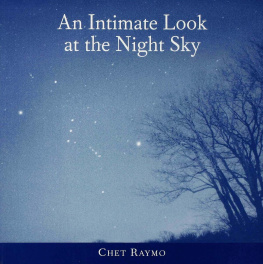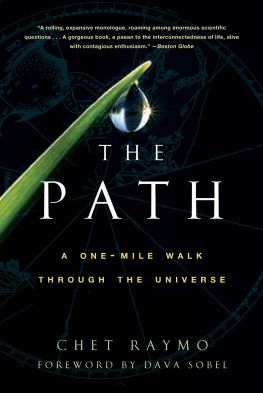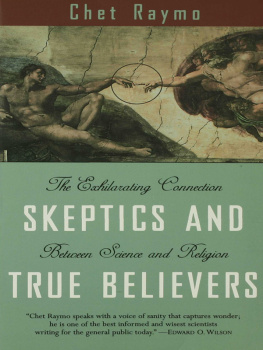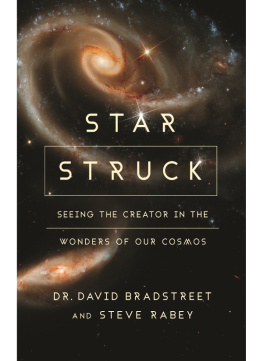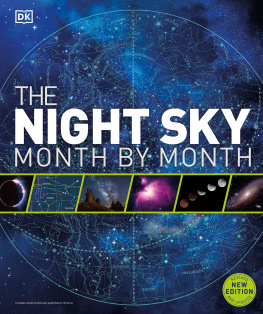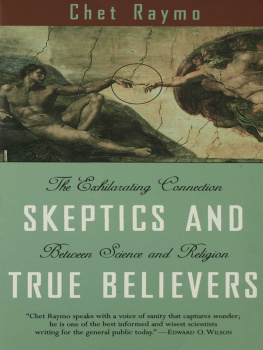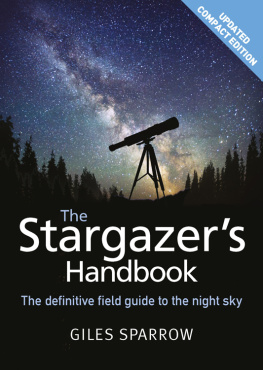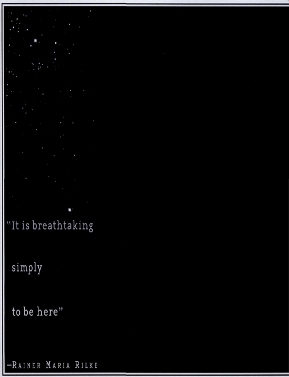An Intimate Look
at the
Night Sky
CHET RAYMO

Copyright 2001 by Chet Raymo
All rights reserved. No part of this book may be reproduced or transmitted in any form or by any means, electronic or mechanical, including photocopying, recording, or by any information storage and retrieval system, without permission in writing from the Publisher.
First published in the United States of America in 2001 by Walker Publishing Company, Inc.; first paperback edition published in 2003.
The poems are from The Poems of Gerard Manley Hopkins, edited by W. H. Gardner and N. H. MacKenzie, Oxford University Press, Inc., New York, revised 1967.
All star maps created by Dan Raymo. Maps from Starry Night Pro astronomy software were adapted using Corel Draw 9.0 and Corel Draw Clipart Collection, which are protected by the copyright laws of the United States, Canada, and elsewhere. Used under license.
Library of Congress Cataloging-in-Publication Data available upon request
eISBN 978-0-802-71916-4
Book design by Maura Fadden Rosenthal/Mspaceny
Printed in the United States of America
10 9 8 7 6 5 4 3 2 1
Contents
This book owes its existence first of all to Jacqueline Johnson of Walker & Company who conceived the idea and invited its making. This is the second book I have done with Jackie; every author should have such a gifted editor. Thanks also to publisher George Gibson, design director/managing editor Marlene Tungseth, designer Maura Rosenthal, and the other fine people at Walker & Company, and to my agent, John Williams. Dan Raymo of Platypus Multimedia prepared the star maps. Although I have never met them face-to-face, I owe a debt of gratitude to Guy Ottewell and Fred Schaff for sharing their vast knowledge of the night through their various books and publications. Tom Lorenzin has been a steady friend to both me and the night. Mike Home shared with me more starry nights than I can count. My wife, Maureen, rolled over many a night to find my side of the bed empty; she knew where I was. My son Tom has fed my enthusiasm for astronomy since he was a toddler. To all of my family, a hearty thanks.
This book is dedicated to the many Stonehill College students over the years with whom I have had the honor of sharing my love of the night, especially John Darak and Chris Asbell who are mentioned herein.
WE ARE CHILDREN OF THE NIGHT. Our species evolved under an overarching canopy of stars, undiminished by industrial smog or artificial light. During long hours of darkness there was nothing much to do but sleep and wonderwonder at the dreamy dots of light that moved overhead in uncountable numbers. Onto this screen of stars our ancestors imposed their hopes and fears. They found suitable candidates for worship among celestial bodies, especially the Sun with its giving and taking of warmth and light. The rains came and went with the stars. The flooding of rivers and fertility of the soil. And there was terror, too. The frighteningly unexpected. Comets. Eclipses. Stars that appeared out of nowhere and then faded away. Within this apparent chaos our ancestors found order. They recorded the movements of Sun, Moon, planets, and stars, and invented geometrical space, linear time and number to account for what they saw. Science and mathematics, as we know them today, got their start in the eastern Mediterranean world of the fifth, fourth, and third centuries B.C.E. at the hands of sky watchers. Our cultural evolution is bound up in so many ways with observations of celestial phenomena that it is hard to imagine what our story might have been had our planetlike Venusbeen permanently shrouded in cloud.
Hard to imagine, too, is the intimacy your ancestors had with the night. Today, satellite photographs of the Earth from space show the night side of the planet ablaze with artificial light. Those of us who live in or near cities might live and die without ever seeing things that were as familiar to our great-grandparents as the Sun and Moon: the Milky Way, the Pleiades, nebulosities, faint comets, the zodiacal light. We spend our evenings indoors in front of the television or computer monitor, oblivious of the beauty and terror of the celestial abyss.
This book has as its purpose the reestablishment of intimacy with the night. To that end, it offers the knowledge of the dome of night that would have been the heritage of every child in an earlier era. It offers, as well, the rich intellectual tradition that flows down to us from the earliest sky watchers, through the astrologers and astronomers of ancient civilizations, to Copernicus, Kepler, Galileo, Herschel, Einstein, Hubble, and the many nameless engineers of national space agencies who have sent spacecraft to visit distant worlds. "What makes the desert beautiful is that somewhere it hides a well," wrote the aviator-poet Antoine de Saint-Exupry. The beauty we see in the sky, too, takes its power from what we don't seeor see only with the mind's eye. Use the star maps of this book to find and learn the planets, stars, and constellations. Then read the essays that connect what you see to the extraordinary unseen wonders of the universe. Let your imagination break through the apparent dome of night and flow into the realm of supernovas, black holes, galaxies, quasars, and the radiation of the big bang, arriving ultimately at the singular moment of creation, when space, time, matter, and energy flowed from an infinite and mysterious source. We are made of star dust. Our story is bound up with the story of stars that lived and died long before the Sun and Earth were born. Our fate is intimately tied to the fate of the universe.
The star maps are drawn for an observer at a typical midnorthern latitude 40 degrees north, about the latitude of Philadelphia, Chicago, San Francisco, Tokyo, Rome, and Madridbut they will be suitable for most folks who live in the northern hemisphere. If you live south of latitude 40 degrees, the stars will stand a bit higher on the southern horizon and lower in the north. If you live north of 40 degrees, the opposite will be true. Unless otherwise noted, the seasonal maps are drawn for about 10 o'clock in the evening on January 15, April 15, July 15, and October 15, but you will soon learn to make adjustments east or west for other times or dates. As you stand under the stars, don't neglect the things that are not on the maps. The five naked-eye planets are a "movable feast"; appendix 1 will help you recognize them. You might see "shooting stars" on almost any clear night, but for the best times of the year to view meteors, see appendix 2. And don't fail to watch for satellites moving with a stately elegance against the background of the stars; you will see them during the hours after sunset and the hours before dawn when they catch the rays of the Sun as they move high overhead.
"It is breathtaking simply to be here," wrote the poet Rainer Maria Rilke. Breathtaking to stand under a starry sky and look deeply into the universe of galaxies. Breathtaking to participate in the constantly changing drama of the night sky. Star watching at its best is a total experience, involving all of the sensesthe sights, sounds, tastes, smells, and tactile sensations of the night. It is this complete immersion into darkness and light, informed by knowledge, open to mystery, that renews our intimacy with the cosmos.

